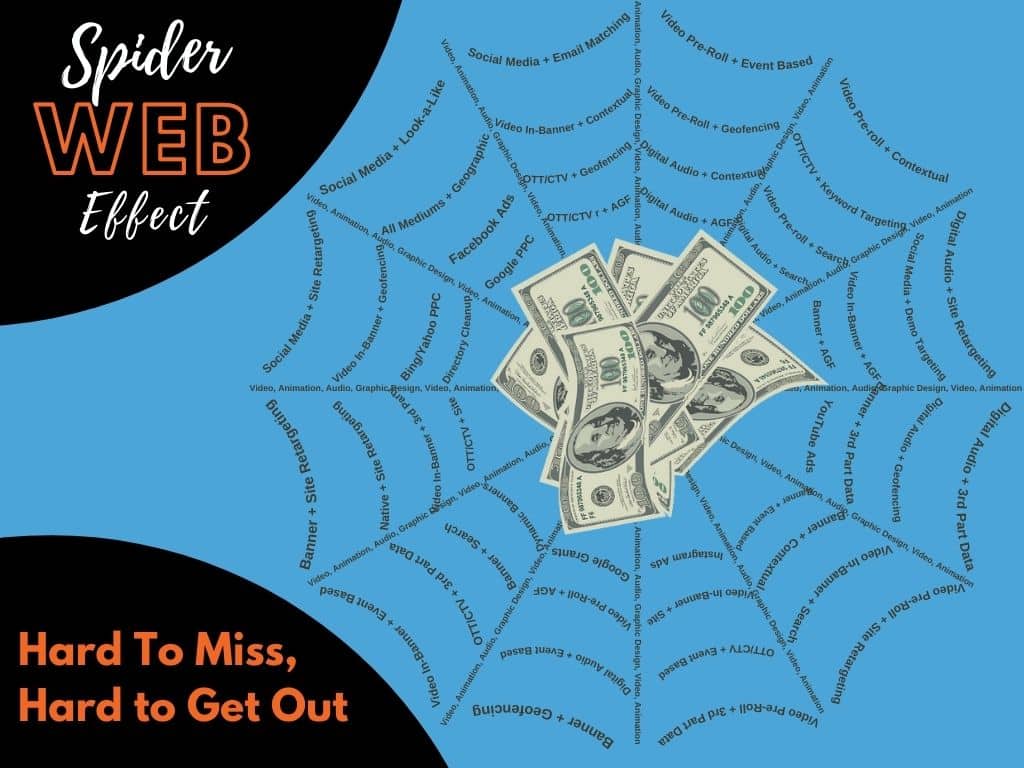Digital Advertising Spider Web Effect: Hard to Miss, Hard to Get Out
Think about how many flies a spider catches if it only runs one sticky line. You’re probably thinking “zero,” or maybe a few if it’s lucky, right? You’re right! One sticky line is not very effective, but when the spider intersects multiple lines into its web, it creates a stronger, more efficient means of capturing prey. Think of your advertising campaign as a spider web where each thread is made up of an advertising medium and targeting tactic with the creative elements interlocking each strain together.
What Makes a Good Digital Advertising Spider Web?
- Don’t Stretch the Budget Thin: A spider web with many weak, non-sticky threads can create a large web, but if the threads aren’t able to hold onto it’s prey, if they break easily, or support the weight of the entire web, it’ll be ineffective. With your digital advertising spider web, you’ll need to ensure that each thread of your campaign is strong; and, with so many different combinations of advertising media, targeting tactics, and creative options, you’ll end up with more options than your budget can support. Remember, it’s better to have a few less elements in your campaign to make the components you are using stronger for a better web.
- Don’t Put All of Your Spider Eggs in One Basket: On the flip side, if you have a healthy budget that you only put into one endeavor, your digital advertising spider web will be strong, but it will have a lot of gaps and missed opportunities to capture your target audience and keep them engaged.
- Make Sure Your Web Is Showstopping (Don’t Skimp on Creative): The advertising messaging you put in front of people needs to be consistent across all media. Saying the right thing at the right time in a given medium is important. This doesn’t mean using the same exact creative everywhere, but it means that your brand is consistent, your messaging is complimentary, and your creative is engineered to get a desirable reaction. The creative helps hold the spider web together, but it’s also what gets your audience to stick. Our favorite analogy (yes, another analogy!) when it comes to good media targeting and bad creative is that it’s like being on a date with the right person but saying all the wrong things. Even if you are soulmates, saying the wrong things will kill your chances at a second date.
- Think About the Fly’s (aka User’s) Journey: People are bombarded with an estimated 3,000 branding/advertising messages every day. We are constantly on multiple devices and applications. Selecting the right media for your audience is key, but visualizing their potential usage and paths is also important. Let’s give a recent example. Our agency was tasked to present a plan that targets college-aged and unemployed adults for a government job placement initiative.
Let’s focus on the younger target audience and describe a very real scenario: Imagine a 20-ish year old male working on homework around noon. While he works, he is listening to Spotify (digital audio ad thread here). Then, he hears a “ding” indicating an Instagram notification, so he checks the IG app on his phone (Instagram ad thread here. While he is on his phone, he decides to check the weather (Banner ad and Video Pre-Roll ad thread here). He sees it’s nice outside, so he decides to take a lunch break outdoors and while he eats he streams his favorite show on his tablet (OTT ad thread here) while also casually scrolling on his phone (multiple ad thread potential here). This is a very specific scenario, but it’s also a good example of how the right target audience could trigger 5+ different advertising messages within a 10-minute window.
The more media you are advertising on, the more likely you’ll get your target audience’s attention and the more credible your brand becomes to that audience. As an additional thread to this scenario, search (SEM and SEO) are very important because if your advertising works, there is a good chance they’ll turn to Google to search your brand. - Place Your Web in the Right Spot (Targeting Is Key): Being on the right media is important, but having the right targeting tactics in place will greatly improve your advertising campaigns’ success. We often use a combination of targeting through multiple sources including third party data, search, contextual, geofencing, addressable geofencing, look-a-like audiences, email targeting, cross-device matching, first party data, geographic, site retargeting, and event-based geofencing. There is a lot of information out there on your target audience; leverage it and build your digital advertising spider web in the right location!
- You Must Have a Spider for Your Web: A digital advertising spider web is wonderful for catching leads, but what an advertiser does with those leads is equally (if not more) important. An advertiser should have a solid website/landing page, sales strategy, and customer service process to capitalize on the leads. A good digital advertising spider web with no spider is a waste.

